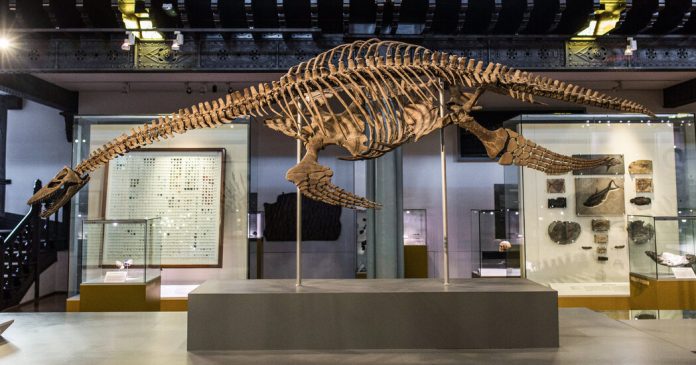LONDON — Hundreds of thousands of years earlier than the primary (alleged) sighting of the Loch Ness monster, populations of large reptiles swam by means of Jurassic seas in areas that are actually Britain. Generally known as plesiosaurs, these long-necked creatures have been thought to have dwelled solely in oceans.
However a discovery revealed in a paper final week by researchers in Britain and Morocco added weight to a speculation that some Loch Ness monster lovers have lengthy clung to: that plesiosaurs lived not simply in seas, however in freshwater, too. That would imply, they reasoned excitedly, that Nessie, who is usually described as trying rather a lot like a plesiosaur, actually might reside in Loch Ness, a freshwater lake.
Native papers have celebrated the discovering. It “provides additional credit score to the concept Nessie might have been capable of survive and even thrive in Loch Ness,” mentioned an article on web page 32 of the Inverness Courrier, a biweekly newspaper within the Scottish Highlands. “Loch Ness Monster bombshell,” blared a headline from Britain’s Day by day Categorical tabloid. “Existence of Loch Ness Monster is ‘believable’” learn headlines in The Scotsman, The Telegraph and elsewhere, seizing on a phrase within the College of Bathtub’s announcement of the research’s findings.
This isn’t the primary research to search out that plesiosaurs lived in freshwater. “This new research is solely offering extra proof for sure members of this group residing in freshwater,” mentioned Dean Lomax, a paleontologist and visiting scientist on the College of Manchester. “We’ve all the time recognized this.”
However Nick Longrich, the lead creator of the research, mentioned his crew had one of many stronger circumstances for it as a result of they discovered fossils of 12 plesiosaurs, proof that it was not only one plesiosaur that wandered into freshwater after which died there.
“The extra plesiosaur fossils found in freshwater environments, the extra it will additional construct the image to elucidate why plesiosaurs could be turning up in freshwater environments around the globe,” mentioned Georgina Bunker, a pupil who was a co-author of the paper.
Dr. Longrich, a paleontologist and evolutionary biologist on the College of Bathtub, mentioned it was “fully sudden” to search out the fossil of a plesiosaur that had lived in an 100-million-year-old freshwater river system that’s now the Sahara.
Whereas on a analysis journey to Morocco, he was sifting by means of a field within the again room of a store when he noticed a “type of chunky” bone, which turned out to be the arm of a five-foot lengthy child plesiosaur. Dr. Longrich paid the cashier not more than 200 Moroccan Dirham, or about $20, after bargaining to convey down the worth, and introduced the fossils again to Britain for additional research.
“As soon as we began trying, the plesiosaur began turning up all over the place,” he mentioned. “It reminds you there’s rather a lot we don’t know.” (The fossils will likely be returned to museums in Morocco at a later date, he mentioned.)
Because the information of the research made headlines final week, some Nessie followers have been hopeful. George Edwards, who was for years the skipper of a Loch Ness tourism boat referred to as the Nessie Hunter, mentioned that for him the brand new research confirmed how creatures might adapt to outlive in new environments — and that the world is filled with mysteries. Take the coelacanth, a bony fish that was thought to have develop into extinct thousands and thousands of years in the past however was present in 1938 by a South African museum curator on a fishing trawler. “Lo and behold, they discovered them, alive and kicking,” Mr. Edwards mentioned. “Something is feasible.”
Mr. Edwards mentioned he had seen unexplained creatures in Loch Ness loads of occasions: “There’s received to be a household of them.” From what he has seen, the creatures have a giant arched again, no fins and are considerably harking back to a plesiosaur.
However there’s one element that some Nessie lovers might have ignored of their embrace of the plausibility of Nessie’s existence: Plesiosaurs grew to become extinct concurrently dinosaurs did, some 66 million of years in the past. Loch Ness was solely shaped about 10,000 years in the past, and earlier than that it was ice.
Valentin Fischer, an affiliate professor of paleontology on the College of Liège in Belgium, mentioned that it might presently be not possible for a marine reptile just like the plesiosaur to reside in Loch Ness.
The primary recorded sighting of Nessie dates again to the sixth century A.D., when the Irish monk St. Columba was mentioned to have pushed a creature into the water. However international curiosity was revived within the twentieth century, after a British surgeon, Col. Robert Wilson, took what grew to become probably the most well-known photograph of the Loch Ness monster in 1934. Sixty years later, the {photograph} was revealed to be a hoax.
Steve Feltham, a full-time monster hunter who has lived on the shores of Loch Ness for 3 many years, mentioned the British-Moroccan research was attention-grabbing, however that it was irrelevant to his search. Ever because it grew to become clear that the well-known 1934 photograph of Nessie was faux, he has stopped believing that Nessie was a plesiosaur. Plesiosaurs have to return up for air, so he figures he would have seen it in the course of the 12 hours a day that he scans the loch. As an alternative, he scans the water for big fish that appear like a ship turned the wrong way up.
“I battle to consider any bona fide Nessie hunter that also believes within the plesiosaur,” he mentioned. “The hunt has moved on from that.”


